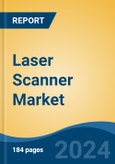Virtual Simulation is the fastest growing segment, North America is the largest regional market
Speak directly to the analyst to clarify any post sales queries you may have.
10% Free customizationThis report comes with 10% free customization, enabling you to add data that meets your specific business needs.
Key Market Drivers
The increasing adoption of industrial automation and Industry 4.0 initiatives significantly propels the global laser scanner market. Manufacturing sectors worldwide are integrating automated systems, robotics, and smart factories to enhance efficiency, reduce human error, and accelerate production cycles. Laser scanners are indispensable in these environments, providing the precise spatial data required for robot guidance, automated inspection, and the creation of digital twins for entire production lines.Key Market Challenges
The global laser scanner market faces a significant challenge due to the high initial investment costs associated with advanced laser scanning systems. These substantial upfront expenditures often deter potential adopters, particularly smaller and medium-sized enterprises (SMEs) operating with limited capital budgets. The requirement for significant capital outlay restricts market penetration by making sophisticated laser scanning technology less accessible.This financial barrier directly hampers the broader expansion and growth of the market. Enterprises evaluating new technologies prioritize a clear return on investment, and the high purchase price of laser scanning equipment can extend the payback period, rendering the investment less attractive.
Key Market Trends
Artificial Intelligence and Machine Learning for data processing are transforming how laser scanner data is analyzed, interpreted, and utilized across industries. These technologies enable automated feature recognition, predictive maintenance, and sophisticated anomaly detection, moving beyond raw point cloud generation to deliver actionable insights. According to the National Association of Manufacturers' (NAM) Manufacturing Leadership Council, in surveys conducted in 2023, 72% of surveyed manufacturers reported reduced costs and improved operational efficiency after deploying AI technology. The integration of AI streamlines complex data workflows, reducing manual effort and accelerating decision-making.Key Market Players Profiled:
- Faro Technologies Inc.
- Trimble Inc.
- Maptek Pty Ltd
- Perceptron, Inc.
- Topcon Corporation
- Renishaw plc
- Hexagon AB
- Nikon Corporation
- 3D Systems Corporation
- Autodeck Inc.
Report Scope:
In this report, the Global Laser Scanner Market has been segmented into the following categories:By Type:
- 2D
- 3D
By Application:
- Virtual Simulation
- Quality Control
- Inspection
By Region:
- North America
- Europe
- Asia-Pacific
- South America
- Middle East & Africa
Competitive Landscape
Company Profiles: Detailed analysis of the major companies present in the Global Laser Scanner Market.Available Customizations:
With the given market data, the publisher offers customizations according to a company's specific needs. The following customization options are available for the report.Company Information
- Detailed analysis and profiling of additional market players (up to five).
This product will be delivered within 1-3 business days.
Table of Contents
Companies Mentioned
The companies profiled in this Laser Scanner market report include:- Faro Technologies Inc.
- Trimble Inc.
- Maptek Pty Ltd
- Perceptron, Inc.
- Topcon Corporation
- Renishaw plc
- Hexagon AB
- Nikon Corporation
- 3D Systems Corporation
- Autodeck Inc.
Table Information
| Report Attribute | Details |
|---|---|
| No. of Pages | 184 |
| Published | November 2025 |
| Forecast Period | 2024 - 2030 |
| Estimated Market Value ( USD | $ 4.15 Billion |
| Forecasted Market Value ( USD | $ 6.51 Billion |
| Compound Annual Growth Rate | 7.7% |
| Regions Covered | Global |
| No. of Companies Mentioned | 11 |









